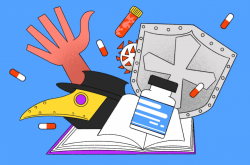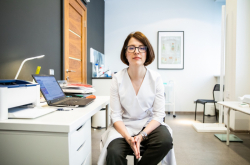You started your project this March. Looking back, what did you find most difficult during its initial stages?
Polina Poleschuk: As an editor, it is hard for me to search for people who can write sensible texts. Approving the materials, deciding on formats and composing columns is a continuous struggle, as well. At first, our list of classification headings was not clear enough; now, the columns’ headings hold answers to particular questions, and the associated materials help to solve users’ particular problems.
Apart from oncology-related issues, you also write also about medicine in general, ethical issues and doctors’ experiences. How do you choose your topics?
When we were still Master’s students in a science communication program, we discussed our future title’s structure, and decided on using a wide range of topics. By all means, oncology remains our main focus, but even this topic is now associated with many misconceptions and myths. Turning a blind eye to them would’ve been plain stupid. We still have few sources of information about oncology in Russian, and at least a half of those is based on questionable materials: things made up by journalists and bloggers, pseudo research, personal experiences and the like.
Working with this topic can be very hard. In order to write a single oncology-related instruction takes at least a week’s time, you have to study the associated legislation, and talk to doctors. Everything related to scientific medicine is a bit easier, as there already are many reputable doctors who have their blogs, constantly improve their knowledge, and have a good enough command of English to read the most recent research articles.

You have a dedicated column where you tell stories of people who are fighting cancer. Do you have any problems with establishing communication with patients?
For starters, let me tell you how this column came about. In the Bumaga newspaper, there’s an Expatriates column that tells stories of people who came to live in Russia from abroad. Their editors prepared detailed guidelines for these people who talk about things they like or dislike here. We’ve been wanting to write patients’ stories for a long time already, but weren’t sure about the format. Anna Kosinskaya, who created the Expatriates column, advised us to make use of their experience, decide on a list of questions, and look for potential interviewees.
I can’t say that communicating with people we write about is hard. Oftentimes, we don’t even have to meet them in person: many patients spend considerable time in social networks or post a lot in Instagram. Some write to us on their own. This column is quite important, as their stories give doctors an opportunity to look at particular problems from a different angle.

Profilaktika.Media was launched by students and graduates of ITMO’s Science Communication Master’s program. What about now?
We are still a small team. Liza Babitskaya and myself are the journalists. Liza Dubovik, who also wrote for us, now focuses more on her work as a science communicator and PR-specialist for the Cancer Prevention Foundation. Sasha Golovin, who was once our website’s editor and now does his Crytmysh podcast sometimes consults us, especially in everything that has to do with technical issues.
We plan that Liza Babitskaya will focus more on scientific medicine articles. What’s more, we now collaborate with Anastasia Golubnichnaya, reporter for the St. Petersburg tv-channel, who is a skillful journalist with much experience in the field of social change. She started with stories about oncology patients, and will continue focusing on the topic.

How does the experience you got during your Master’s program help you in your project?
Lizaveta Babitskaya: The first thing that comes to my mind is scientometrics. When we write our texts or interview experts, we always cite sources. Those can be both research articles or medical reviews from reliable sources like UpToDate, Medscape, Mayo Clinic, as well as relevant guidelines.
When citing a research article, you have to check it. Sometimes, it proves to be unscientific, with weak methodology, false statistics and such. You can’t really cite such an article. Unfortunately, many investigations conducted in Russia tend to make such mistakes. For instance, I am currently working on a text dedicated to myopia in children. Many Russian doctors still prescribe eye exercises in such a case. Even though this approach is ineffective. The problem here is that there is very little research that proves it. Why? No one really studied this topic abroad, as they already know that eye exercises don’t help treat myopia. The research conducted in Russia often serves the interests of those doctors who promote eye exercises for commercial reasons. This is a complex topic, and we have to explain all these nuances.

How can you tell that you can’t trust a particular source?
The simplest way to do that is through a scientific journal. Everyone must have heard about predatory publishing. Such titles can be easily detected by checking with databases like Web of Science and Scopus: they just won’t be mentioned there. Still, sometimes this is not enough. It’s a lot better to study the article’s hypothesis, experiment and statistics, and its citation rate, though this might pose a problem to people without specialized knowledge. Also, not everyone has access to Web of Science and Scopus, which is why non-specialists shouldn’t rely on such sources as PubMed. It’s better to use resources like UpToDate, where the articles have already been assessed by an expert team.
You recently launched a contest for authors who want to try to participate in your project. How do you plan on working with them from now on?
Polina Poleschuk: We got some fifteen applications, and that is a good response. For now, we are analyzing the letters we got. Judging by the ones I saw, the applicants are people with considerable background, they are sincerely interested in journalism and they are ready to study. On the other hand, we can’t call ourselves super experts, but we can still give them an opportunity to understand what journalism is really like. That it’s not about serving one’s interests, but working within the boundaries of the Media Act, with no censorship, about informing the public and taking responsibility for your words.
In future, we’ll give the authors a test assignment. This way, we’ll be able to see how they work with sources, process and analyze information. If everything is ok, they can join us for several months and occasionally become part of our team.

What are your key goals for the nearest future?
We have a plan for at least a year. In this time, we are planning to become a reputable resource with an audience of about 100,000 users a month. That may be not much, but we prefer them to be really engaged and active people . We also plan to publish at least one text a day and at least one instruction or article that has to do with particular diseases on a weekly basis.
What’s more, we plan to launch an independent section “A guide to diseases” that will be our counterpart of Cancer.org, and continue developing the “Instructions” section. Though lately we’ve been focusing on instructions that have to do with scientific medicine, we are already starting to write instructions on our main subject. For instance, Liza is now preparing an instruction on screening lung cancer. The section’s main purpose is to explain to people where they should go and what to do if they face a particular problem. This is our flagship section that makes us different from other medical portals, as it is aimed at common users rather than specialists
Finally, we are already forming our own expert council whose participants will check and verify our texts. To the best of my knowledge, any popular science editions about medicine in Russia are yet to have one.




